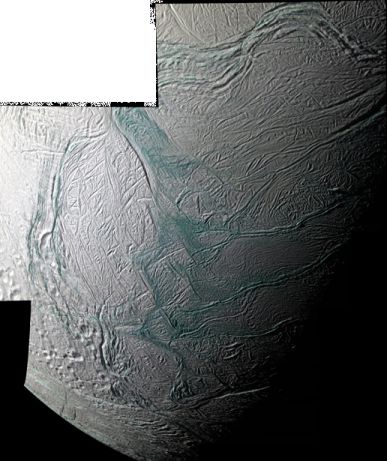The scientists want to sample the gases and dust emitted from the plumes using the instruments on board Cassini

The Cassini spacecraft, which has been in the Saturn system for over four years, will make two approach flights this month to the York geysers Enceladus. The first of these is expected today, November 9, and will be the closest Cassini has ever come to any body in the Saturn system. Cassini will pass a total of 25 kilometers above the cracked surface of Enceladus. The next approach flight, on October 31, will be more distant - 196 kilometers above the surface.
The focus of today's approach flight is on the plumes coming out of the geysers. The spacecraft's particle sensing instruments will sense what is happening in a deeper environment than ever before, and will attempt to directly sample particles and gases. Scientists are intrigued by the possibility of flowing water, perhaps even an ocean, on the surface of Enceladus. Traces of organic materials were also discovered near Enceladus and raised the possibility of life.
While Cassini's cameras and optical equipment were the focus of the previous approach flight to Enceladus in August, this time the focus will be on examining the composition of the plume rather than photographing the surface.
"We know that Enceladus produces several hundreds of kilograms per second of gas and dust and that these materials mainly contain water vapor and ice." said Tamas Gambosi, a Cassini scientist at the University of Michigan in Ann Harbor. "The water vapor and evaporation of ice grains from Enceladus contributes most of the mass we find in Saturn's magnetosphere.
"One of the great scientific puzzles we are trying to understand is what happens to the gas and dust released from Enceladus, including what percentage of the gas becomes ionized plasma and their distribution in the magnetosphere." Gambosi says.
On the next flight, on October 31, the cameras will once again be at the center of things and this time they will photograph the cracks and fissures in the South Pole area that look like tiger stripes.
During the series of approach flights to Enceladus, the scientists will also try to paint a continuous picture of the changing icy moon. For example, during the approach flight on August 11, the temperature measurements above one of these strips were lower than in previous approach flights. The degree of heat above the strip known as the Damascus sulcus (Damascus Sulcus) was about 160-167 degrees Kelvin less than the heat measures measured in March this year - 180 degrees Kelvin.
"We don't know if this is due to a real ceiling of this strip, or if this happened because we looked more closely, at a relatively small area, and missed the hottest spot," said John Spencer, Cassini scientist in charge of the infrared spectrometer at the Southwest Research Institute in Boulder. Colorado.
Results transmitted by the magnetometer during the approach in August indicate changes in the density of the plume compared to the previous encounters. The data from the two upcoming flights will help scientists understand these observations.
In the next two years, four more approach flights to Enceladus are planned, which will bring the total number of approaches to seven during the extension part of the Cassini flight.
Enceladus' geysers were discovered by Cassini in 2005. Since then, scientists have argued about the force that drives them, because the moon is so tiny, its diameter is only about 500 kilometers. The following flights may provide the answer.
For information on the NASA website
More of the topic in Hayadan:

3 תגובות
And I want to know why there is no consistency in the articles you write. Sometimes it is 25 km above the ground, in another place it is 50 km. Yes, it is the same flight.